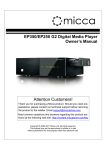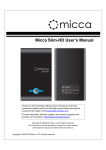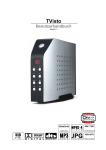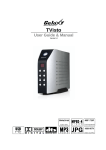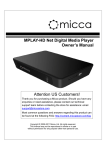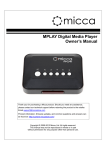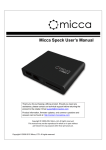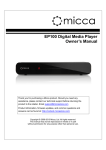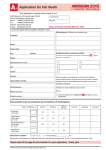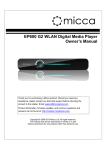Download Micca MPLAY-HD 1080P Owner`s manual
Transcript
MPLAY-HD 1080P Digital Media Player Owner’s Manual Thank you for purchasing a Micca product. Should you need any assistance, please contact our technical support before returning the product to the retailer. Email [email protected] Product information, firmware updates, and common questions and answers can be found at: http://content.miccastore.com/ Copyright © 2009-2012 Micca, Ltd. All rights reserved. This manual may not be reproduced in whole or in part without permission for any purpose other than personal use. 1 Introduction 1.1 Features Thank you very much for purchasing this media player. We hope you will enjoy using it as a great home entertainment device. This player has the following functionality: 1.1.1 A/V Output HDMI output for high-definition video and digital audio Composite and component video with stereo audio for analog AV connection S/PDIF optical interface for high-fidelity digital audio Adjustable video output resolution (NTSC, PAL, 480p, 720p, 1080i, 1080p) 1.1.2 Multimedia Playback Supports major audio, video and image file formats (1080p HD video decoding) Video format: AVI, MKV, TS, TP, TRP, M2TS, M2T, MPG, MP4, M4V, MOV, VOB, ISO, IFO, DAT, WMV, ASF, RM, RMVB, FLV Video codec: H.264/AVC, VC-1(WMV9-HD), MPEG1/2/4, DivX, Xvid, RV8/9/10 Audio format: MP3, OGG, WMA, WAV, AAC, FLAC, AC3, DTS, True-HD, DTS-MA/HR Photo format: JPEG, BMP, GIF, TIF, PNG 1.1.3 Subtitle Display Displays SRT, SMI, SUB, SSA, IDX+SUB subtitle files Supports embedded or external subtitle files Adjustable subtitle size, color, location, time sync, and encoding 1.1.4 Storage Devices Play files from USB flash drives, USB hard disk drives, and SD/SDHC flash memory cards. Automatically scans storage devices and Supports copying & moving files among Card, USB, and HDD Supports FAT16, FAT32, NTFS, and EXT3 1.1.5 USB 2.0 Support USB HOST ports (2) for connecting USB storage devices Note: All the information contained in this manual was correct at the time of publication. However, as our engineers are always updating and improving the product, your device’s software may have a slightly different appearance or modified functionality than presented in this manual. 1.2 Packing List Part Quantity Media Player 1 A/V cable 1 Remote Control 1 AC/DC adapter 1 User Manual (printed) 1 Note: The actual contents in the package might be different from the packing list in this manual. 1.3 Precautions This player’s design has your safety in mind. In order to safely and effectively use this player, please read the following before usage. 1.3.1 Usage Cautions Users should not modify this player. If a commercial hard disk drive is being used, the environmental temperature should be between 40 to 95 degrees Fahrenheit. 1.3.2 Power The player’s power supply voltage is DC 5V 2.5A. When using this player, please connect the supplied AC adapter or AC adapter cable to the player’s power jack. When placing the adapter cable, make sure it is not damaged or subject to pressure. To reduce the risk of electric shock, unplug the adapter first before cleaning it. Never connect the adapter to the player in a humid or dusty area. Do not replace the adapter or cable’s wire or connector. 1.3.3 Radio Interference If not properly shielded, almost all electronic devices will get radio interference. Under some conditions, your player might get interference. The design of this player has followed the FCC/CE standard, and adheres to the following rules: 1) This player may not cause harmful interference; 2) This player could accept some interference received including interference that may cause undesired operation. 1.3.4 Repair If the player has a problem, you should take it to an appointed repair center and let the specialists do the repair, never repair the player yourself, you might damage the player or endanger yourself or your data. 1.3.5 Disposing of the Player When you dispose of the player, be sure to dispose it appropriately. Some countries may regulate disposal of electrical device, please consult with your local authority. 1.3.6 Hard Disk Cautions The player uses external storage devices for data storage. New USB hard drives need to be properly formatted prior to use. Users should carefully read the Frequently Asked Questions chapter and check our website for latest information before formatting the hard disk. Physical impact may damage the hard disk drive. When hard drive errors occur, please use CHKDSK to scan and fix problems. All data stored in the player may be lost due to physical impact, electrical shock, power lost, HDD format etc. Please backup your data. It is suggested to perform a disk defragment after a long period of usage. Regularly backup the data in the hard disk so that it can be recovered in the event of data corruption or loss. Our company takes no responsibility for loss of data stored on the hard disk. 1.3.7 Additional Precautions When using this player, please do not let the player come into contact with water or other liquid. If water is accidentally spilled on the player, please use a dry cloth to absorb the spillage. Electronic products are fragile. Please be gentle during use; avoid shaking or hitting the player, and do not press the buttons too hard. Do not let the player come into contact with water or other liquids. Do not disassemble, repair or change the design of the player, any damage done will not be included in the repair policy. Do not press the buttons of the player too hard. Avoid hitting the player with hard objects, shaking the player, and stay away from magnetic fields. Electrostatic discharge may cause the product to malfunction. When this happens, unplug the power cable and the product will return to normal operation next time it is powered on. 2 Layout Overview 2.1 Front Panel The front panel contains indicator lights and the IR remote control sensor: Name Description Stand By A red LED that indicates when the player is in stand-by mode IR Sensor The sensor for receiving remote control commands Power A blue LED that indicates when the player is powered on Button Pressing the button toggles the player between powered on and stand-by mode. 2.2 Rear Panel The rear panel of the player contains various audio and video connectors: Name Description DC IN DC power input, 5V 2.5A. Only use the AC adapter provided with the player. CVBS/R/L Composite video and analog Left/Right audio output to a TV or home theater with analog AV input. OPTICAL S/PDIF optical digital audio output to a TV or home theater with optical audio input. Y/Pb/Pr Component video output to a TV or home theater with component video input. HDMI Provides digital audio/video to a TV or home theater with HDMI input. 2.3 Side Panel The side panel of the player contains storage device connectors: Name Description USB HOST Two connectors for connecting USB devices such as USB hard drives or USB flash drives. Flash Card Reader A memory card reader slot that supports SD/SDHC flash memory cards. 2.4 Remote Control All player functions can be controlled by using the remote control. See the following for details on the function of each button. 1. POWER 2. HOME 3. OPTION 4. RETURN 5. UP/DOWN 6. LEFT/RIGHT 7. OK 8. SUBTITLE 9. AUDIO 10. GOTO 11. PLAY/PAUSE 12. STOP 13. PREVIOUS 14. NEXT 15. REWIND 16. SLOW 17. FAST FORWARD 18. ZOOM 19. A-B 20. REPEAT 21. DISPLAY 22. SETUP 23. MUTE 24. TV SYSTEM 25. AV/COMP 26. VOL+ 27. VOL- 28. RED 29. GREEN Button 1 POWER Description Press to power on the player. 2 HOME Press to view the home screen menu. 3 OPTION Press to display optional settings when viewing video, listening to music, or displaying slideshow. 4 RETURN Press to return to the previous screen when navigation menus. Press to exit the current folder when in the media browser. 5 UP/DOWN Press the arrow buttons to highlight items as needed. 6 LEFT/RIGHT Press the arrow buttons to highlight items as needed. 7 OK/ENTER Press to proceed with the highlighted item. 8 SUBTITLE Press to open the subtitle menu when viewing videos. Use the UP/DOWN/LEFT/RIGHT arrow keys to change subtitle language, size, position, time sync, encoding, color, and press OK/ENTER to confirm. 9 AUDIO Press to display list of available audio tracks. Use the UP/DOWN arrow keys to select audio track and press OK/ENTER to confirm. 10 GOTO Press to jump to a specific time mark when playing a video. 11 PLAY/PAUSE Press to begin playback of media file. 12 STOP Press to stop playback. 13 PREV Press to go to the previous file when playing photos, music, or videos. Press to go up one page in the media browser. 14 NEXT Press to go to the next file when playing photos, music, or videos. Press to go down one page in the media browser. 15 REWIND Press to fast rewind the current playback. Press repeatedly to change fast rewind speed. 16 SLOW Press to playback in slow motion. Press the PLAY button to resume normal playback. 17 FAST FORWARD Press to fast forward the current playback. Press repeatedly to change fast forward speed. 18 ZOOM Press to zoom when viewing photos or playing videos. Photo zoom levels: 2x, 4x, 8x, 16x. Video zoom levels: 2x, 3x, 4x, 8x. 19 A-B Press to set A-B points when viewing a video and continuously loop between A and B. 20 REPEAT Press to set repeat option when viewing videos: repeat title, repeat all, and repeat off. 21 DISPLAY Press to display information about the currently playing media file. 22 SETUP Press to OK/ENTER the setup menu for changing player settings. 23 MUTE Press to mute audio output; press again to unmute. 24 TV SYSTEM Press to switch between available video output modes when using HDMI: 480p, 720p, 1080i, 1080p. 25 AV/COMP Set the player’s video output to Composite AV or Component Video. 26 VOL+ Press to increase the volume (set volume to max during normal use and use the TV or home theater receiver to control volume). 27 VOL- Press to decrease the volume (set volume to max during normal use and use the TV or home theater receiver to control volume). 28 RED Function changes based on context. Watch for prompts 29 GREEN Function changes based on context. Watch for prompts 3 Connections 3.1 Connecting the Power Supply To connect power to the player: 1) Connect the barrel connector of the AC adapter to the player’s DC IN jack 2) Connect the plug of the AC adapter to the power outlet 3.2 Connecting a USB Device USB storage devices such as USB hard drives or USB flash drives can be connected to the player for playback of media files. 1) Power on the player. 2) Plug in the USB device to one of the USB HOST ports on the back of the player. 3) After about 5-10 seconds, the USB drive will be detected and can be accessed through the player. Note: Please see section 4.1.7 Scan Storage for important information regarding the player’s media library function and automatic scanning of storage devices. 3.3 Connecting a Memory Card Flash memory cards, including SD and SDHC, can be connected to the player for playback of media files. 1) Power on the player. 2) Insert the flash memory card into the card reader on the side of the player. 3) After about 5-10 seconds, the flash memory card will be detected and can be accessed through the player. Note: Please see section 4.1.7 Scan Storage for important information regarding the player’s media library function and automatic scanning of storage devices. 3.4 Audio and Video Connections The player can be connected to a TV/HDTV or home theater system in a variety of methods. For best results, always use the best method available for connection: Results Video Audio Requirement Best HDMI HDMI TV with HDMI input and home theater receiver that can decode Audio over HDMI. Better HDMI Digital Optical TV with HDMI input and home theater receiver with optical audio input. Good Component Digital Optical TV with component input and home theater receiver with optical audio input. Okay Composite Analog L/R TV with composite video and analog audio inputs. 3.4.1 HDMI Connection HDMI provides the best possible video and audio connection. Use this connection whenever possible. 1) Plug one end of the HDMI cable to the player’s HDMI output jack. 2) Plug the other end of the HDMI cable to your TV’s HDMI input jack. 3) Please refer to section 4.3.2 TV System for instructions on how to set the player’s video output signal for best results. 4) Consult the TV’s manual for configuring its inputs. Note: If you have a home theater receiver with HDMI input and output jacks, connect the other end of the HDMI cable to an available HDMI input on the receiver instead of the TV. Consult the receiver’s manual for configuring its inputs. 3.4.2 Digital Audio Connection When using a home theater receiver or sound system that lacks HDMI input, the player’s optical digital audio output can be used. 1) Plug one end of the optical cable to the player’s digital audio jack. 2) Plug the other end of the optical cable to the home theater receiver or sound system’s digital audio input jack. 3) Consult the receiver or sound system’s manual for configuring its inputs. 3.4.3 Component Video Connection When using a TV that does not have HDMI input but has component video, the player’s component video output can be used. 1) Plug one end of the red/blue/green component video cable to the player’s component video jacks. 2) Plug the other end of the red/blue/green component cable to an available component video input on the TV. 3) Please refer to sections 4.3.7 CVBS/YPbPr Select and 4.3.2 TV System for instructions on how to set the player’s video output signal for best results. 4) Consult the TV’s manual for configuring its inputs. Note: Component video connection only carries video signal. The audio signal must be connected separately, such as through digital optical or analog AV connection. 3.4.4 Composite Video and Analog Audio Connection When using a TV that only has composite video input, the player’s composite video and analog audio output can be used. 1) Disconnect any existing HDMI connections from the player – the composite video output of the player is disabled when an HDMI connection is detected. 2) Plug the 3.5mm mini jack of the supplied red/white/yellow AV cable to the player’s CVBS jack. 3) Plug the other end of the red/white/yellow AV cable to an available AV input on the TV. 4) Please refer to sections 4.3.7 CVBS/YPbPr Select and 4.3.2 TV System for instructions on how to set the player’s video output signal for best results. 5) Consult the TV’s manual for configuring its inputs. Note: Only use the 3.5mm-to-RCA cable supplied with this media player. There is no industry standard for 3.5mm-to-RCA cables so a different cable will not have the correct polarity and will not work correctly. Spare replacement cables are available if the cable becomes damaged or lost during use. 3.5 Power On/Off 3.5.1 Power On After connecting the AC power adapter to the player’s DC IN jack, the player will power on and the power indicator light on the front of the player will turn blue. 3.5.2 Initial Setup The first time that the player is powered on, it may ask the user to configure the user interface language and time. After setting the language and time, the player is now ready for use. 3.5.3 Home Screen After power on, the player will go through a start-up process and display the home screen. For best results, refer to ‘4 Settings’ to setup the player. If there is a storage device attached to the player, the player will automatically scan it for media files and build a media library. Please see section 4.1.7 Scan Storage for important information regarding the player’s media library function and automatic scanning of storage devices. 3.5.4 Stand By Place the player into power saving Stand By mode when not in use. To place the player into Stand By, press the POWER button on the front of the player or on the remote control. The red Stand By indicator light will illuminate. To turn the player on, press the POWER button on the front of the player or on the remote control again. 4 Settings The Setup menu allows users to personalize and configure usage preferences for the player. To go into the setup menu, select the Setup icon on the home screen, or press the SETUP button on the remote control. There are four setting groups in the Setup menu, including System, Audio, Video, and Misc. Use the directional LEFT/RIGHT and UP/DOWN buttons on the remote control to select options and press OK/ENTER to confirm setting changes. To cancel a setting change, press the RETURN button. 4.1 System Settings 4.1.1 Menu Language The player’s user interface and menu system can be presented in a variety of different language settings. Note that this setting is only for the player’s user interface and does not affect the language of audio tracks or subtitles. Available settings: English, Simplified/Traditional Chinese, Japanese, Thai, Korean, Spanish, French, German, Italian, Greek, Russian. 4.1.2 Text Encoding The player’s subtitle display supports a variety of different text encodings. Most subtitles will display correctly with Unicode (UTF8), but if a subtitle does not display correctly, try one of the other encoding languages. Available settings: Unicode (UTF8), Simplified Chinese (GBK), Traditional Chinese (BIG5), Japanese(S-JIS), Korean (EUC-KR), Western, Turkish, Central European, Greek, Cyrillic, Hebrew, South-East European. 4.1.3 Startup Auto Play The player can automatically begin playing media files from attached USB drives or SD cards when they are placed into specifically named folders. This feature is useful for playing media files without having to manually browse and start playback. Available settings: Setting Description Off The auto play feature is off. Movies The player will automatically playback any compatible video files found in the folder named “automovie”. Do not use sub folders and the folder name is case sensitive. Music The player will automatically playback any compatible music files found in the folder named “automusic”. Do not use sub folders and the folder name is case sensitive. Photos The player will automatically playback any compatible photos found in the folder named “autophoto”. Do not use sub folders and the folder name is case sensitive. 4.1.4 Time This setting configures the date and time of the player’s internal clock. Setting the date and time of the player is optional and the player will function correctly even if the date and time is not set. Use the directional LEFT/RIGHT buttons to choose date or time field, and UP/DOWN buttons to change field value. When finished, press OK/ENTER to save the date and time entered. 4.1.5 R/RW Auto-Play When this setting is turned on, the player will automatically play any DVD-R/RW disks detected in an attached DVD-ROM drive. Note: only unencrypted DVDs are supported. Available settings: On, Off 4.1.6 Screen Saver The screen saver function displays a small moving icon on a black background when the player has been inactive for a period of time. This feature is useful for preventing image burn-in on TVs or HDTVs with a CRT or plasma display. Available settings: Setting Timing Description Sets the period of inactivity after which the player will display the screen saver. Available values are Off, 2 Minutes, 5 Minutes, 10 Minutes. Sets the image that’s displayed by the screen saver. Options Default – A small image icon will be displayed. Photo Album – Photos from an available storage device will be displayed. If the storage device is removed, this setting will revert back to default. 4.1.7 Keyboard Language This setting is used to select the language for the on-screen keyboard. The on-screen keyboard will only display automatically when it is needed. Available settings: English (Lower Case), Chinese (Zhu Yin), Chinese (Traditional), Chinese (Simplified) 4.1.8 Scan Storage The player uses a media library for organizing media files that it finds on available storage devices. While the media library feature is optional, its use is strongly recommended for the best user experience. The player builds its media library by scanning available storage device for media files. The scanning takes place in the background while the user continues to use the player normally. The first time a storage device is scanned, the time it takes to fully scan the device may be quite long if there are numerous media files. While scanning, the player’s user interface responsiveness may degrade but remain usable. If the user starts playing a media file while the scanning is taking place, the scan will be paused and resume when playback is finished. Each time the player is turned on, or when the storage device is temporarily removed and made available again, the player will do a quick scan of the storage devices to detect any changes and update the media library. The Scan Storage setting adjusts the way in which the player will scan for media files on available storage devices. Available settings: Setting Description Auto Scan On Each time a storage device is detected by the player, it will be scanned for media files. Auto Scan Off The player will not automatically scan any available storage devices. The media library will not be updated. Rescan Storage Manually initiate a scan of available storage devices. Stop Scanning Manually stop all current active storage scans. Note: The scanning process creates a file and folder on the root directory of each scanned storage device. This file and folder contains media library data and should not be deleted. If deleted, the player will need to perform a new scan to rebuild the media library. 4.1.9 Resume Play This setting configures whether the player will offer to resume playback at the last stop point when the user starts to play a video that was played recently. When turned on, the player will prompt the user to resume play back or cancel and start playing from the beginning of the video. Available settings: On, Off 4.1.10 Format For best performance and compatibility, hard drives should be formatted using a Windows based PC using the following parameters: MBR Partition Table, NTFS file system, no compression. To use the player to format a hard disk drive, first make sure all data is copied or moved off of the hard drive before formatting as all data will be permanently erased in the format process. To format the HDD, follow these steps: 1) Connect the hard disk drive to the player 2) Select Format from the Setup System menu 3) Select External HDD from the list and press OK/ENTER on the remote control 4) A warning screen will be displayed asking the user to confirm the format. All data on the hard drive will be erased after the format is complete. To continue highlight OK on the screen and press OK/ENTER on the remote control. To cancel without formatting the hard drive, highlight Cancel and press OK/ENTER. 5) A last and final confirmation screen will be shown. To go back without formatting, highlight Back on the screen and press OK/ENTER on the remote control. To proceed with format, highlight Format and press OK/ENTER. While formatting, the progress bar will rotate. 6) When finished, the player will prompt the user to press OK/ENTER on the remote control to return to the home screen. Note: The player will format the hard disk drive with NTFS file system. 4.1.11 Factory Default This setting will restore all settings back to factory default. 4.2 Audio Settings 4.2.1 Night Mode When turned on, night mode compresses the dynamic range of audio output by the player. This allows the quiet sounds of a movie to be more clearly heard while lowering the volume of loud sounds so as not to bother other people in the home. Available settings: Off, On, Comfort 4.2.2 HDMI Output HDMI Output sets the format of the digital audio carried over the player’s HDMI output. Available settings: Setting Description RAW Audio is sent without being decoded by the player. The TV or home theater receiver must be able to decode the audio. This setting is also known as “bit stream output”. Use this setting for best audio quality if using a home theater receiver with HDMI audio capabilities. LPCM Audio is decoded by the player and down-mixed into two channels for output over HDMI. Use this setting if the TV or home theater receiver lacks multi-channel audio decoding capabilities (i.e. Dolby Digital, DTS). LPCM Multi-Ch Audio is decoded by the player and output over HDMI. Multi-channel soundtracks will not be down-mixed into fewer channels. Use this setting if the home theater is a multi-channel model but cannot decode raw multi-channel sound tracks. 4.2.3 SPDIF Output SPDIF Output sets the format of the digital audio carried over the player’s optical output. Available settings: Setting Description RAW Audio is sent without being decoded by the player. The TV or home theater receiver must be able to decode the audio. This setting is also known as “bit stream output”. Use this setting for best audio quality if using a home theater receiver with multi-channel decoding capabilities. LPCM Audio is decoded by the player and down-mixed into two channels for output over HDMI. Use this setting if the TV or home theater receiver lacks multi-channel audio decoding capabilities (i.e. Dolby Digital, DTS). 4.3 Video Settings 4.3.1 Aspect Ratio Aspect Ratio affects how the player will display content on the TV. It is very important to set the aspect ratio to match the TV, incorrect setting will result in distorted image output. Available settings: Setting Description Pan Scan 4:3 This is one of two settings for use with 4:3 TVs; both settings will correctly display 4:3 videos on a 4:3 TV. The difference is in how widescreen video will be displayed. In Pan Scan 4:3 mode, wide screen videos will have the left and right side cut off, with the center portion of the image filling the 4:3 TV screen. Letter Box 4:3 This is one of two settings for use with 4:3 TVs; both settings will correctly display 4:3 videos on a 4:3 TV. The difference is in how widescreen video will be displayed. In Letter Box 4:3 mode, wide screen videos will be displayed with black bars on the top and bottom of the image. 16:9 Choose this setting if the TV has a 16:9 aspect ratio. 16:10 Choose this setting if the TV has a 16:10 aspect ratio. Many computer monitors have a 16:10 aspect ratio. 4.3.2 TV System The player is able to output video in a wide range of video systems. Consult the TV/HDTV’s manual for which video system it supports. For best results, configure the player’s Video System setting to match the highest quality setting supported by the TV/HDTV. Available TV System settings will change depending on the type of connection used to connect the player to the TV: Connection Type Available Settings HDMI Auto / 480P / 720P 60HZ / 1080i 60HZ / 1080P 60HZ HDMI Recommended: HDMI Auto Component NTSC / PAL / 480P / 576P / 720P 50HZ / 720P 60HZ / 1080i 50HZ / 1080i 60HZ / 1080p 50HZ / 1080P 60HZ Recommended: Highest setting supported by the TV Same as component, but only NTSC and PAL settings will have effect Composite Recommended: NTSC Note: Consult section 4.3.7 CVBS/YPbPr Select for important information regarding component and composite video settings. 4.3.3 Video Zoom When turned on, Zoom Out has the effect of zooming out slightly when playing video. This setting is useful when used with TVs that have severe over-scan problems. Available settings: Setting Description Off Videos are displayed as normal. Use this setting unless the TV has severe over-scan problems. On Videos are displayed slightly zoomed out. Use this setting only if the TV has severe over-scan problems. 4.3.4 Digital Noise Reduction The player can decrease the amount of noise in videos to improve playback quality. Available settings: Setting Description Auto The player will automatically reduce the amount of noise in videos when necessary. Off The player will not perform any noise reduction. 4.3.5 1080P 24FPS The player supports output of 1080P 24Hz at native timing. This mode provides the best result for when viewing 24FPS movies on a TV that supports 24Hz input signal. Available settings: Setting Description On The player will output 24FPS video at native timing. Off The player will output all videos with 50/60Hz timing. 4.3.6 Deep Color The player supports deep color output when a compatible TV is present. Normal TV displays support 24-bit color over HDMI while deep color TV displays support 30bit to 48bit color. It is recommended that this setting be left on Auto so that the player can automatically detect the optimal setting. Available settings: Setting Description Auto The player will automatically detect the optimal setting 12 bit The player will output 12 bits per channel for 36bit color output 10 bit The player will output 10 bits per channel for 30bit color output Off The player will output 8 bits per channel for 24bit color output 4.3.7 CVBS/YPbPr Select When the player is connected using either the composite (CVBS) or component (YPbPr) video connection, this setting must be set to the appropriate value. Composite video and component video outputs cannot be used together at the same time. For convenience, the dedicated CVBS/YPbPr button on the remote control will toggle between composite or component video outputs when pressed. Available settings: Setting Description CVBS The player will output a video signal that is compatible with composite video. Component video output will look discolored and blurry. YPbPr The player will output a video signal that is compatible with component video. Composite video output will be blank, distorted, or in black and white. 4.4 MISC Settings 4.4.1 Version Info This setting displays various system versions and dates. This information will be useful for determining whether a firmware update is available or needed. 4.4.2 USB Upgrade When new firmware becomes available, the player can be updated with this setting. To update the firmware, follow these steps: 1) Download the firmware and place the “install.img” file onto the root directory (i.e. not in any folders) of a USB drive. 2) Plug the USB drive into an empty USB HOST jack on the player. 3) On the player, navigate to the USB Upgrade setting and press OK/ENTER on the remote control. 4) Wait for the player to complete the firmware update. Please be patient as it may take several minutes to complete, during which the screen may be blank or show “no signal”. Do not interrupt the process or power off the player. 5) When finished, the player will show the initial setup screen (See ‘3.5.2 Initial Setup’) 5 Media Library The player maintains a media library of all media files found on available storage devices such as USB flash drives, USB hard drives, and SD/SDHC flash memory cards. For details on how the player builds the media library, please see section 4.1.7 Scan Storage. Once the media library is built, the Movies, Music, and Photo categories will be populated with media content. To access the media library, select the Movies, Music or Photo icon from the home screen. 5.1 Browsing and Playing Movies To view movies and video files in the media library, select the Movies icon from the home screen. By default, video files will be listed in thumbnail view in alphabetical order. Use the LEFT/RIGHT/UP/DOWN buttons on the remote control to highlight a video and press OK/ENTER to play the highlighted video. While browsing videos, the following remote control functions can be used for navigation: Button Description UP/DOWN/LEFT/RIGHT Move the cursor to highlight video files PREV/NEXT Go to previous or next page OK/ENTER Play the selected video file RETURN Return to the home screen OPTION Display the additional operations menu (Please see below) 5.1.1 Movie Browsing Options The option menu when browsing video provides access to additional browsing features and capabilities. To access the option menu, press the OPTION button on the remote. Setting Description Search Search for a movie by name. An on-screen keyboard will be shown. Enter the first few letters of a movie, select OK, and all matching videos in the media library will be shown. To see the entire list of movies again, open the options menu and select All Movies. Thumbnails All video files in the media library will be shown as thumbnail icons. List All video files in the media library will be shown as a list. Preview All video files in the media library will be shown as a list, highlighting a video will cause the video to begin playing in a small preview box on the right side of the screen. All Show DVDs Show only DVD-type files, such as VOB, IFO, ISO, and VIDEO_TS Go to Folder Exit from the media library browser and go to the folder of the currently highlighted video. Name Sort videos by name Size Sort videos by size Most Viewed Sort videos by number of times viewed Recently Added Sort videos by date/time added to the media library 5.1.2 Video Playback Controls During video playback, the following remote control commands are available: Button Description PLAY/PAUSE Press to play or pause the current video. STOP Press to stop playback. SLOW Press to playback in slow motion. FAST FORWARD Press to fast forward the current playback. Press repeatedly to change fast forward speed. FAST REWIND Press to fast rewind the current playback. Press repeatedly to change fast rewind speed. PREV Press to go to the previous video. NEXT Press to go to the next video. REPEAT Press to set repeat option when viewing videos: repeat title, repeat all, and repeat off. ZOOM Press to zoom when viewing photos or playing videos. Video zoom levels: 2x, 3x, 4x, 8x. DISPLAY Press to display information about the current videos. GOTO Press to jump to a specific time mark when playing a video. AUDIO Press to change audio tracks for the current video. SUBTITLE Press to open the subtitle menu for the current video. A-B Press to set A-B points when viewing a video and loop OPTION Press to display optional settings when viewing video. 5.1.3 Video Subtitle Menu When subtitles are available, the subtitle menu can be used to configure how subtitles are displayed. To use the subtitle menu, press the SUBTITLE button while viewing a video. Setting Description Subtitle Displays a list of available subtitles for the current video, and the currently selected subtitle. Change this setting to select different subtitles. Offset All subtitles will be centered on the screen, but how far the subtitle is from the bottom of the screen can be adjusted through this setting. Size The size of the subtitle can be enlarged or reduced through this setting. Time Sync Some subtitles are not perfectly in sync with the video, which happens mostly with external subtitle files. This setting can be used to adjust the time sync between the video and the subtitle display. Text Encoding Most subtitles will display correctly with Unicode(UTF8), but if a subtitle does not display correctly, try one of the other encoding settings. Color The color of the subtitle display can be changed for better visibility. 5.1.4 Movie Playback Options The option menu provides on-screen access to some of the features that are otherwise available through buttons on the remote control. This menu can be helpful when the buttons are hard to see, such as in dim light. To use the subtitle menu, press the OPTION button while viewing a video. Setting Description Subtitle Select to view the subtitle menu for the current video. Audio Select to view available audio tracks for the current video. Repeat Title Select to repeat the current video. Repeat All Select to repeat all videos in the media library. Repeat Off Select to turn repeat off. 5.2 Browsing and Playing Music To play music files in the media library, select the Music icon from the home screen. By default, video files will be listed in list view in alphabetical order. Use the UP/DOWN buttons on the remote control to highlight a video and press OK/ENTER to play the highlighted video. While browsing music, the following remote control functions can be used for navigation: Button Description UP/DOWN Move the cursor to highlight music files PREV/NEXT Go to previous or next page OK/ENTER Play the selected music file RETURN Return to the home screen OPTION Display the additional operations menu (Please see below) 5.2.1 Music Browsing Options The option menu when browsing music provides access to additional browsing features and capabilities. To access the option menu, press the OPTION button on the remote. Setting Description Search Search for a music file by name. An on-screen keyboard will be shown. Enter the first few letters of a file, select OK, and all matching music files in the media library will be shown. To see the entire list of movies again, open the options menu and select All Songs. Thumbnails All music files in the media library will be shown as thumbnail icons. List All music files in the media library will be shown as a list. Preview All music files in the media library will be shown as a list, highlighting a music file will cause the file’s info and thumbnail displayed in a preview box on the right side of the screen. Go to Folder Exit from the media library browser and go to the folder of the currently highlighted music file. All Songs Display all songs Albums Display by albums Artists Display by artists Genres Display by genres Years Display by years Playlists Display by available playlists Recently Played Sort music files by recently played Recently Added Sort music files by date/time added to the media library Name Sort music files by name 5.2.2 Music Playback Controls During music playback, the following remote control commands are available: Button Description PLAY/PAUSE Press to begin playback, press again to pause. STOP Press to stop playback. FAST FORWARD Press to fast forward the current playback. Press repeatedly to change fast forward speed. FAST REWIND Press to fast rewind the current playback. Press repeatedly to change fast rewind speed. PREV Press to go to the previous song. NEXT Press to go to the next song. While a song is playing, the user can navigate out of the current folder and browse other folders without affecting playback, the song will continue to play. 5.2.3 Music Playback Options The option menu provides on-screen access to additional music playback options. To use the subtitle menu, press the OPTION button while playing a song. Setting Description Repeat Off Select to turn repeat off Repeat One Select to repeat only the current song Repeat All Select to repeat all songs in the media library Shuffle Loop Select to shuffle play all songs in the media library 5.3 Browsing and Viewing Photos To view photos in the media library, select the Photo icon from the home screen. By default, photos will be listed in thumbnail view in alphabetical order. Use the LEFT/RIGHT/UP/DOWN buttons on the remote control to highlight a photo and press OK/ENTER to begin displaying a slide show starting with the current photo. While browsing photos, the following remote control functions can be used for navigation: Button Description UP/DOWN Move the cursor to highlight photos PREV/NEXT Go to previous or next page OK/ENTER View the highlighted photo full screen RETURN Return to the home screen OPTION Display the additional operations menu (Please see below) 5.3.1 Photo Browsing Options The option menu when browsing music provides access to additional browsing features and capabilities. To access the option menu, press the OPTION button on the remote. Setting Description Search Search for a photo by name. An on-screen keyboard will be shown. Enter the first few letters of a file, select OK, and all matching photos in the media library will be shown. To see the entire list of movies again, open the options menu and select All Photos. Thumbnails All photos in the media library will be shown as thumbnail icons. List All photos in the media library will be shown as a list. Preview All photos in the media library will be shown as a list, highlighting a photo will cause the file’s info and thumbnail displayed in a preview box on the right side of the screen. Photo Directory Browse for photos by going through folders/directories Leaf Folder View All photos are organized into stacks based on their folder Date View All photos are organized into stacks based on their date Albums All photos are organized into stacks based on available albums Go to Folder Exit from the media library browser and go to the folder of the currently highlighted photo. Name Sort photos by name Recently Added Sort photos by date/time added to the media library Recently Played Sort photos files by recently viewed 5.3.2 Photo Viewing Controls While viewing photos, the following remote control commands are available: Button Description PLAY/PAUSE Press to view photo full screen If Slide Show Timing is not set to Off, slideshow will start STOP Press to stop viewing photo full screen PREV Press to go to the previous photo. NEXT Press to go to the next photo. ZOOM When not viewing a slideshow, press to zoom in or out the image. DISPLAY Press to display information about the current photo. Note: To play a slideshow, make sure that the Slide Timing setting in the option menu is not set to OFF. 5.3.3 Photo Viewing Options The option menu provides on-screen access to additional photo viewing options. To use the subtitle menu, press the OPTION button while viewing a photo full screen. Setting Description Slide Timing Sets the time delay between photos in a slideshow Slide Transition Sets the transition effect between photos in a slideshow Repeat Off Select to set repeat to off Repeat All Select to repeat all photos in the media library Shuffle Loop Select to shuffle view all photos in the media library Background Music Select to set music for playback as background music during slideshow 6 File Browser While the media library is easy and convenient to use, the file browser presents an alternate way to browse and play media files. The file browser also contains additional functionalities not available through the media library, such as file copying/deleting/renaming, and creation of playlists. To access the file browser, select the File icon from the home screen. A list of available storage devices types will be shown: Select a storage device type and all available storage devices of the select type will be show. The following image shows a case where there are two USB storage devices available: Navigating through a storage device is similar to navigating the folders on a computer. While using the file browser, the following remote control commands are available: Button Description UP/DOWN/LEFT/RIGHT Move the cursor to highlight files or folders PREV/NEXT Go to previous or next page OK/ENTER Enter the highlighted folder, or play the selected media file RETURN Return to the previous screen or exit from the current folder OPTION Display the additional operations menu (Please see below) GREEN Display the file operations menu (Please see below) 6.1.1 File Browsing Options The option menu when browsing files provides access to additional browsing features and capabilities. To access the option menu, press the OPTION button on the remote. Setting Description Thumbnails All files and folders will be shown as thumbnail icons. List All files and folders will be shown as a list. Preview All files and folders will be shown as a list, highlighting a file or folder will cause the file’s info and thumbnail to be displayed in a preview box on the right side of the screen. All Media The file browser will show all files media files on the storage device Movies The file browser will only show movie files found on the storage device Photos The file browser will only show photo files found on the storage device Music The file browser will only show music files found on the storage device 6.1.2 File Operations The file browser has the capability to rename, copy, or delete files. It can also create music file playlists and photo albums. To access the file operations menu, press the GREEN button on the remote while highlighting a file or folder in file browser. Setting Description Copy Copy the highlighted file or folder – the user will be prompted to select the destination location Delete Delete the highlighted file or folder Move Move the highlighted file or folder – the user will be prompted to select the destination location Rename Rename the highlighted file or folder Edit Playlist If the highlighted file is a .M3U playlist file, it can be edited by selecting this option, such as for deleting or adding songs. Edit Photo Album If the highlighted file is a photo album file, it can be edited by selecting this option, such as for deleting or adding photos. Multiple Select Perform copy, delete, move, create playlist, or create photo album on multiple files or folders. 6.1.3 Multi-File Operations To perform file operations on multiple files, first press the GREEN button on the remote while highlighting a file or folder in file browser, then select Multiple Select from the file operations menu. The multi-file operations menu will display: The multi-file operations menu has two sections, the right section is a file/folder browser box, the left section shows files and fodders that have been selected. While in the multi-file operations menu, the following remote control commands are available: Button Description UP/DOWN Move the cursor to highlight files or folders LEFT/RIGHT Switch between the left or right boxes of the menu OK/ENTER Enter the highlighted folder – to exit from the current folder, highlight the “..” folder at the top – DO NOT press the RETURN button. PREV/NEXT Go to previous or next page PLAY/PAUSE Add or remove the current file or folder from the list STOP Clears all files or folders from the file list GREEN Display the file operations menu (Please see below) After adding the desired files or folders to the file list, press the GREEN button on the remote to initiate multi-file operations. Setting Description Copy Copy the list of files or folders – the user will be prompted to select the destination location Delete Delete the list of files or folders Move Move the list of files or folders – the user will be prompted to select the destination location Save Playlist If the list of files or folders contains music files, they can be added together into a new playlist. The user will be prompted to enter a name for the playlist. Save Photo Album If the list of files or folders contains photos, they can be added together into a new photo album. The user will be prompted to enter a name for the album. Once a playlist or album is created, it will be available in the media library for future use. 7 Troubleshooting The following are some common questions and answers. If the following does not provide the answer you are looking for, please check the FAQ section on http://content.miccastore.com to see if any updated answers have been posted. You may also send an email to [email protected] for personalized help. No video output, or distorted video on screen. Most likely, the player has not been set to the correct output mode. To change the output mode of the player, press the <TV System> button on the remote twice and wait 5 seconds. Each time this is done, the player cycles to the next output mode. Repeat this for up to 10 times to cycle through all of the available output modes. When the correct output mode is encountered, the TV display will be correct. How to update the player firmware in recovery mode. If a firmware update fails or if the player shows strange or erratic behavior, its firmware might have been corrupted. Please follow these steps exactly as described to perform a firmware reflash in recovery mode: 1. Re-download the firmware from http://content.miccastore.com/micca-mplay-hd 2. Unpack the firmware ZIP file and copy the “install.img” file onto an empty USB drive and plug it into the media player. 3. Unplug the AC adapter from the back of the player. 4. While pressing and holding the power button on the front of the player, plug in the AC adapter to the player. 5. Continue to hold the power button for 10 seconds and let go. These steps puts the player into firmware recovery mode and will flash the firmware from the USB drive. The recovery mode will take several minutes, during which your TV may not display anything on the screen. When the update is finished, the player will automatically display the initial setup screen on the TV. Media library displays error message or does not scan. If the media library displays an error message when accessed, or does not scan the drive for updates, the library database might be corrupted. To fix this issue, connect the storage device to a computer and delete the “.part” file, and the “.Theater” folder from the root directory of the drive. Perform an error-checking scan on the device to fix any errors that may be on the drive. Connect the device to the player and the media library should now be created without issues. Information in this manual is believed to be accurate and reliable but Micca Ltd assumes no responsibility for its use nor for any infringement of patents or other rights of third parties which may result from the use of this manual or the product. Micca reserves the right to change product specifications at any time without notice. Micca, MPLAY-HD, and the Micca logo are trademarks of Micca Ltd. Other trademarks referenced in this manual are the properties of their respective owners. © 2012 Micca Ltd. All rights reserved.





































